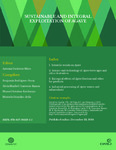
Please use this identifier to cite or link to this item:
http://ricaxcan.uaz.edu.mx/jspui/handle/20.500.11845/563| Title: | Extraction of saponins from leaves of agaves |
| Authors: | Ortíz Torres, Dora Lilia Galván Valencia, Marisol Delgadillo Ruíz, Lucía Cabral Arellano, Francisco Javier Bañuelos Valenzuela, Romulo Esparza Ibarra, Edgar León |
| Issue Date: | 22-Dec-2014 |
| Publisher: | Centro de Investigación y Asistencia en Tecnología y Diseño del Estado de Jalisco A.C. |
| Abstract: | The agave or maguey is endemic to America and Mexico is the place where you will find the largest number of species of agave. In Zacatecas, Mexico, in the south and southeast regions of the state grown Agave tequilana Weber (blue agave) and A. salmiana ssp. crassispina (green agave) for the main production of beverages like “aguamiel, “pulque” and “mezcal”, but due to the growth of this last activity, are being generated large amounts of waste solid such as bagasse and leaves of agave, which are important to evaluate their possible use. Zacatecas generated annually at least 21000 tons being about 30 percent agave leaves and the rest agave bagasse. Currently they are not given an application to the leaves of agave and has been found to exist in these residues some secondary metabolites of interest as saponins. Agave saponins are amphipathic glycosides with triterpene or steroid skeletons whose structural diversity is related to the wide range of biological effects are source sapogenins basis for synthesis of therapeutic importance sterols. But the extraction, purification and identification of these compounds are methodological challenges. The aim of this work is to extract saponins and characterize the waste generated of the agribusiness mezcal. Characterized by optical and scanning electron microscopic bagasse fiber and infrared spectroscopy the content of organic matter, and calcium carbonate was evaluated. The analysis of the composition of the leaves indicate a high content of crude fiber but low content in fat and protein. Extracts from fresh leaves which were purified by column chromatography and analyzed by thin layer chromatography were obtained to evaluate saponins. All with the intention of seeking the possible uses of these compounds and the reduction of waste generated in the production of mezcal. |
| URI: | http://hdl.handle.net/20.500.11845/563 |
| ISBN: | 978-607-96619-1-5 |
| Other Identifiers: | info:eu-repo/semantics/publishedVersion |
| Appears in Collections: | *Documentos Académicos*-- UA Ciencias Biológicas |
Files in This Item:
| File | Description | Size | Format | |
|---|---|---|---|---|
| 2014 ISBN 978-607-96619-1-5 Sustainable and Integral Exploitation of Agave.pdf | 789,45 kB | Adobe PDF |  View/Open |
This item is licensed under a Creative Commons License
